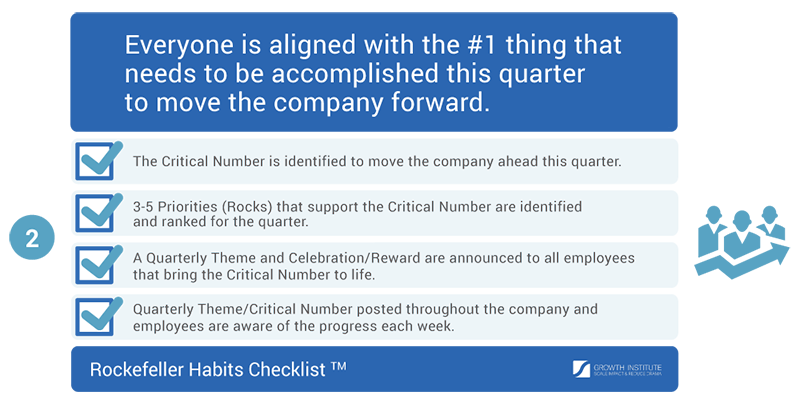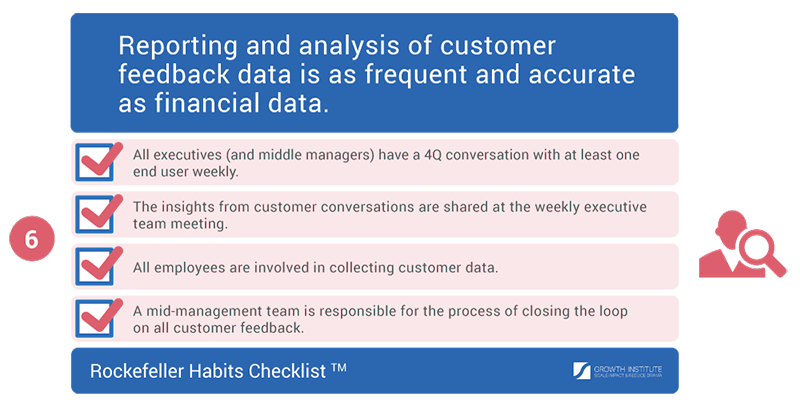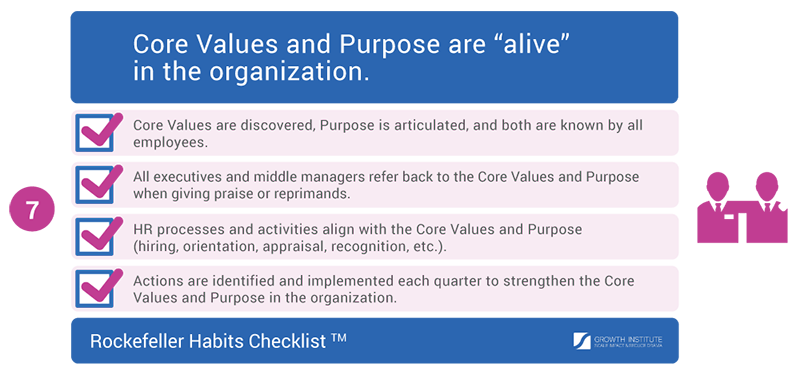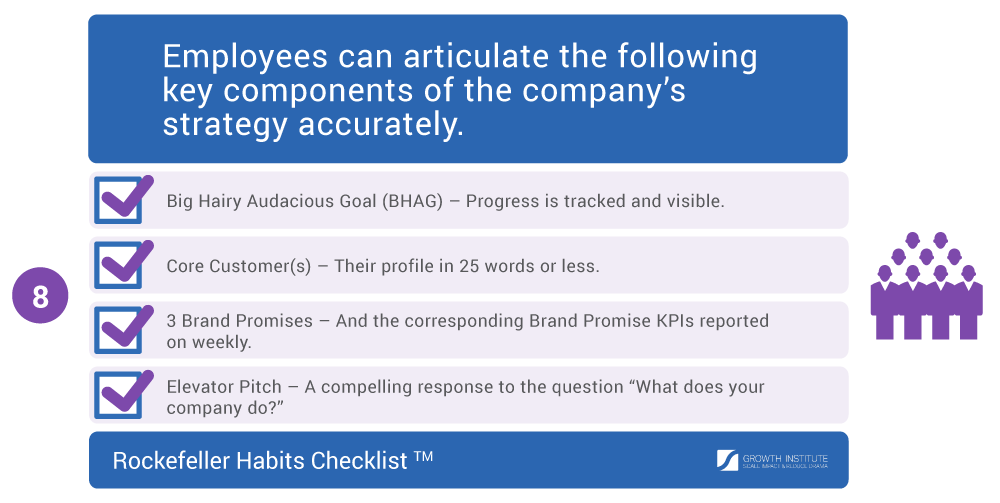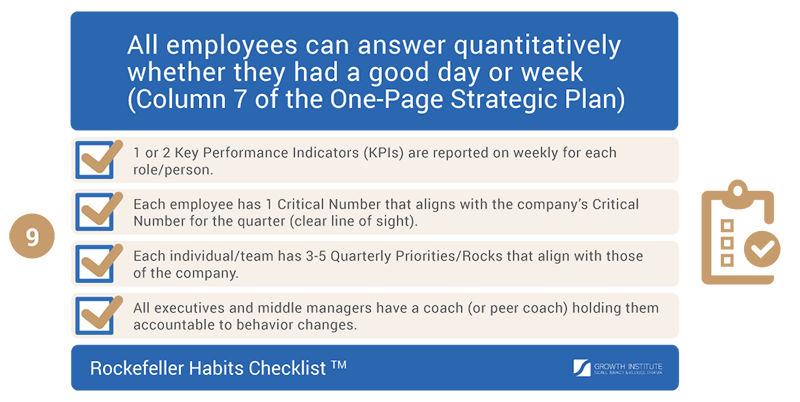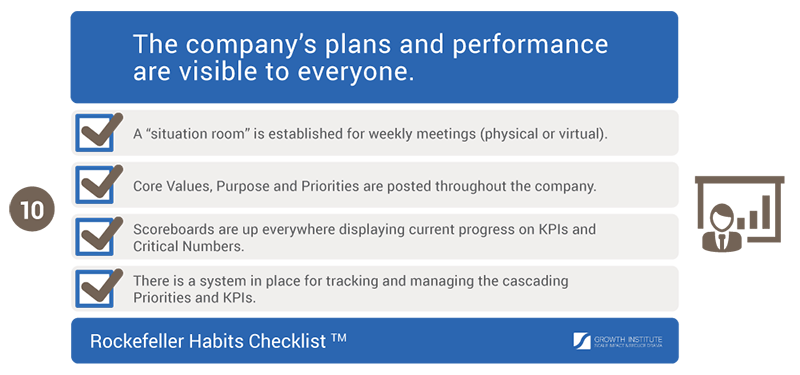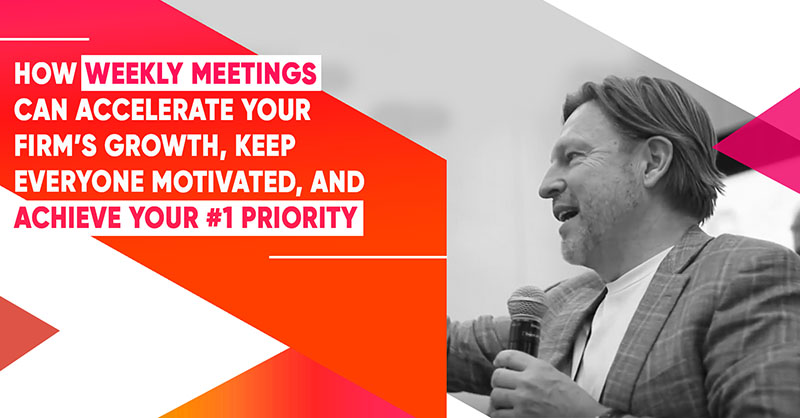10 Rockefeller Habits — The Framework For Scaling Up Your Business NOW
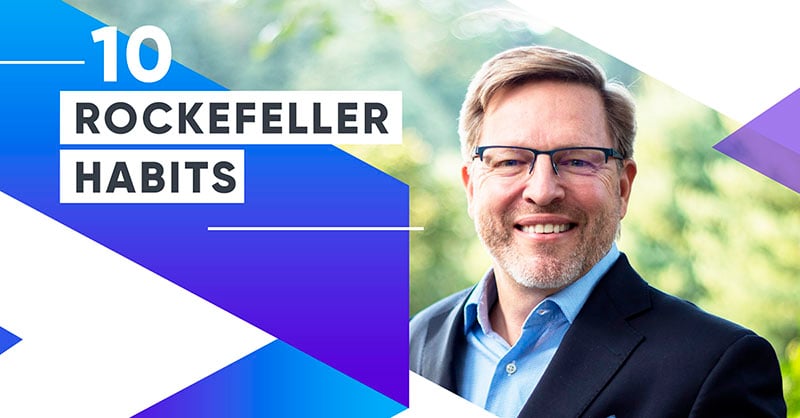
Before We Start – Download the Free Rockefeller Habits Checklist!
To maximize the value of this article, download the Rockefeller Habits Checklist now. As you read, you can follow along and assess where your company stands in implementing these proven execution habits.
📥 [Download the Rockefeller Habits Checklist Here]
By the end, you’ll have a clear framework to improve execution, enhance alignment, and scale your business with discipline.
Let’s dive in!
In 2014, Canadian eyewear company Coastal.com was purchased by Essilor International for CAD$430 million, in what was the largest investment in an e-commerce company in Canadian history.
Coastal.com continues to wow customers, engage employees and deliver results to shareholders because of the processes that it’s put in place for flawless execution. Namely:
-
Listening to customers and employees
-
A meeting rhythm to discuss and implement what’s learned
-
And setting priorities based on this input
Coastal.com’s founder and CEO Roger Hardy credits these stellar results to the disciplined execution of The Rockefeller Habits.
When it comes to the best framework to execute your company’s strategy, I proudly stand by our Rockefeller Habits Checklist. This simple set of habits has already helped over 70,000 companies scale up while reducing the time needed to run the business — many of which scaled to $10million, $100million, and a few, to a billion and beyond. That’s the dream, isn’t it?
The 10 habits that make this checklist have not changed for over 100 years since John D. Rockefeller implemented them in his business — the result of which made him the wealthiest man ever, even by today’s standards.
Download the "10 Rockefeller Habits Checklist"
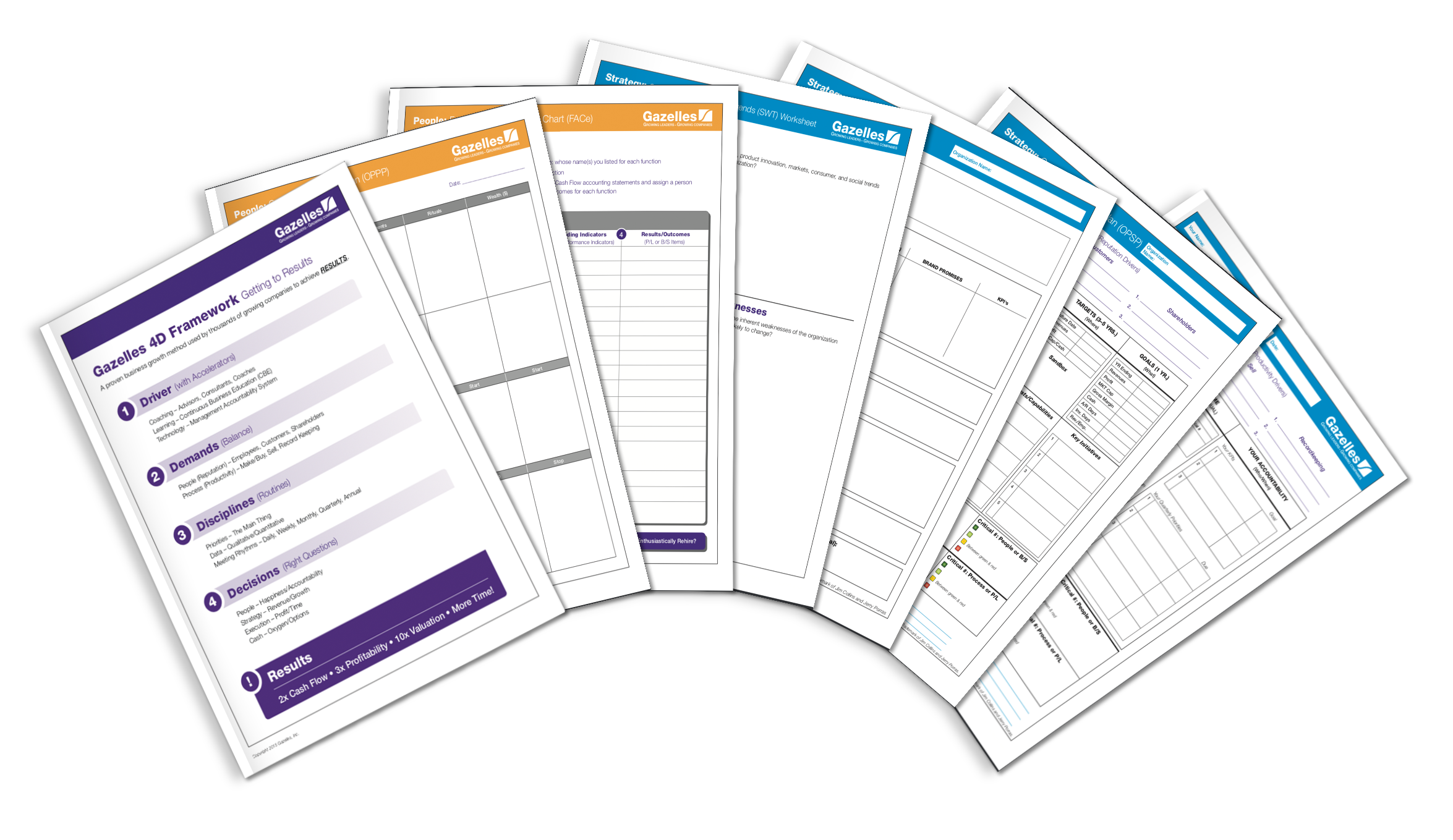
Why Discipline (Routine) Matters
“Goals without routines are wishes; routines without goals are aimless.”
Of course it matters. We know this theoretically, but I’d like to hammer home just how important having a routine is to attaining your goals. My mantra at Gazelles, “Routine sets you free” is the key factor in our methodologies and tools.
Clear Vision (Goals) + Discipline (Routine) = Success
You might want to pick up a guitar, but unless you take lessons and have the discipline (routine) to practice, you won’t get anywhere. Similarly, business leaders who are continually realizing their visions are also the ones with clear goals and routines in place.
With this in mind, let’s dive straight in.
Here is a little background story behind the Rockefeller Habits explained in this short video:
What are the 10 Rockefeller Habits?
-
The executive team is healthy and aligned
-
Everyone is aligned with the #1 thing that needs to be accomplished this quarter to move the company forward
-
Communication rhythm is established and information moves through the organization quickly
-
Every facet of the organization has a person assigned with accountability for ensuring goals are met
-
Ongoing employee input is collected to identify obstacles and opportunities
-
Reporting and analysis of customer feedback data is as frequent and accurate as financial data
-
Core values and purpose are “alive” in the organization
-
Employees can articulate the key components of the company’s strategy accurately
-
All employees can answer quantitatively whether they had a good day or week
-
The company's plans and performance are visible to everyone
Rockefeller Habit #1
The Executive Team Is Healthy And Aligned
-
Team members understand each other‘s differences, priorities, and styles.
-
The team meets frequently (weekly is best) for strategic thinking.
-
The team participates in ongoing executive education (monthly recommended).
-
The team is able to engage in constructive debates and all members feel comfortable participating.
The very first habit spotlights having a healthy executive team that is aligned with the company’s main vision.
In his book, The Five Dysfunctions of a Team: A Leadership Fable, Patrick M. Lencioni details unhealthy organizational situations that will derail a leadership team:
-
Absence of Trust
-
Fear of Conflict
-
Lack of Commitment
-
Avoidance of Accountability
-
Inattention to Results
I suggest tackling these issues — if any of them exist in your organization — before moving on to any other habit on the list. It is crucial that your team has a level of trust that allows for healthy debates and constructive conflicts.
They need to be able to hash out brutal facts and challenge each other without the fear of hurt feelings or office politics. This in turn will allow everyone to stay laser-focused on a single priority creating clarity and power throughout the whole organization.
With this under your belt, you are ready to take on the other habits.
Rockefeller Habit #2
Everyone Is Aligned With The #1 Thing That Needs To Be Accomplished
This Quarter To Move The Company Forward
-
The Critical Number is identified to move the company ahead this quarter.
-
3-5 Priorities (Rocks) that support the Critical Number are identified and ranked for the quarter.
-
A Quarterly Theme and Celebration/Reward are announced to all employees that bring the Critical Number to life.
-
Quarterly Theme/Critical Number posted throughout the company and employees are aware of the progress each week.
“It was like going to the moon and back: Either we were going to do it, by all working together toward this singular goal [like Apollo 13], or die trying.” — Ben Godsey, President of ProService Hawaii.
It’s tempting to have a few “main” priorities, but that just means your focus will be pulled in different directions, thus not really achieving anything of significance. For true scalability to occur, I urge you to prioritize one goal, and make sure everyone is on board to achieving it.
Scaling a company takes time — it’s all about taking a step forward, checking in, and adjusting accordingly. This can only happen if there are regular check-ins and goals. One such goal is the Quarterly Goal that allows for small wins which leads to your #1 Priority of your company’s focus.
Case Study - The City Bin Co.
In 2009, when Ireland was in deep recession, The City Bin Co. founder Gene Browne needed a way to get out of the predicament he found his business in. While he had initially tapped into the ideas from Mastering the Rockefeller Habits as he grew his business, he was still hit hard by the global economic crisis.
At a two-day “Mastering the Rockefeller Habits” workshop, he realized that he hadn’t been giving enough thought to the Quarterly Themes/Goals to align his quickly expanding employees. So he and his team asked themselves, “What is the single most important thing going on in the business
in the next 90 days?”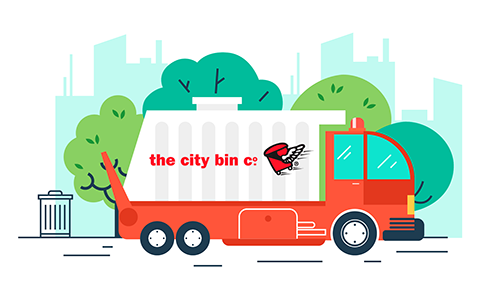 One of the themes/goals that they came up with was “Life Begins at 40” to raise profitability while recovering from the recession. The goal was to increase the company’s monthly earnings by 40,000 euros a month either through recurring revenue or annual savings. Employees were welcome to submit ideas to raise cash or slash the budget.
One of the themes/goals that they came up with was “Life Begins at 40” to raise profitability while recovering from the recession. The goal was to increase the company’s monthly earnings by 40,000 euros a month either through recurring revenue or annual savings. Employees were welcome to submit ideas to raise cash or slash the budget.
“The economy had contracted so much that a lot of companies in Ireland were closing down,” says Browne. “‘Life Begins at 40’ was saying that if we can get to this magic figure, it’ll ensure that we can ride through this economic storm.”
The company managed to achieve its goal.
Rockefeller Habit #3
Communication Rhythm Is Established And Information Moves
Through The Organization Accurately And Quickly
-
All employees are in a daily huddle that lasts less than 15 minutes.
-
All teams have a weekly meeting.
-
The executive and middle managers meet for a day of learning, resolving big issues, and DNA transfer each month.
-
Quarterly and annually, the executive and middle managers meet offsite to work on the 4 Decisions (Strategy, Execution, People, Cash).
“To move faster, pulse faster”
Meetings have gotten a bad rep, with some corners eschewing the benefits of meetings. However, I believe in daily, weekly, monthly, quarterly, and annual “Meeting Rhythms” help to address the number one challenge that people face when working together: communication.
It might sound counterintuitive to have this many meetings, but when executed properly it actually saves everyone a lot of time in the long run. Communication will become much more open and smooth, and your team will have the clarity and feedback they need to focus on the company’s #1 Priority.
Here is a breakdown on how long each meeting should run:
-
Daily Huddle: 5 - 15 minutes
-
Weekly Meeting: 60 - 90 minutes
-
Monthly Management Meeting: Half to full day
-
Quarterly and Annual Planning Meeting: One to three-day offsite meeting
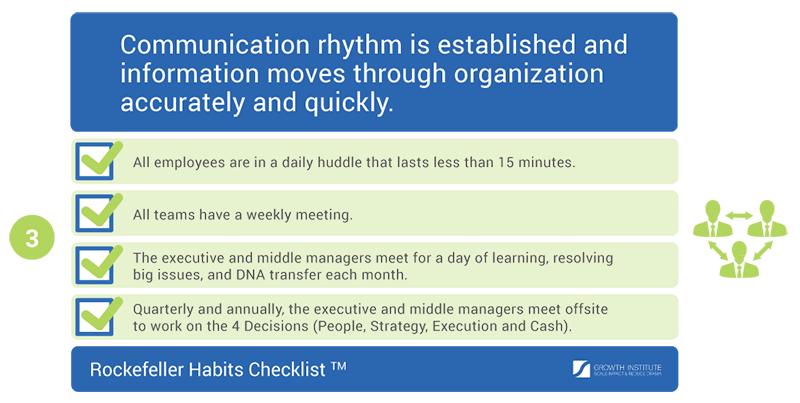
Rockefeller Habit #4
Every Facet Of The Organization Has A Person Assigned
With Accountability For Ensuring Goals Are Met
-
The Function Accountability Chart (FACe) is completed (right people, doing the right things, right).
-
Financial statements have a person assigned to each line item.
-
Each of the 4-9 processes on the Process Accountability Chart (PACe) has someone that is accountable for them.
-
Each 3-5 year Key Thrust/Capability has a corresponding expert on the Advisory Board if internal expertise doesn’t exist.
“If more than one person is accountable, then no one is accountable, and that’s when things fall through the cracks.”
Getting accountabilities clear throughout the organization is crucial. There should be one accountable person assigned to each cell within the organization and this needs to be clear throughout the organization. Of course, this doesn’t mean this person is the boss or gets to make all the decisions.
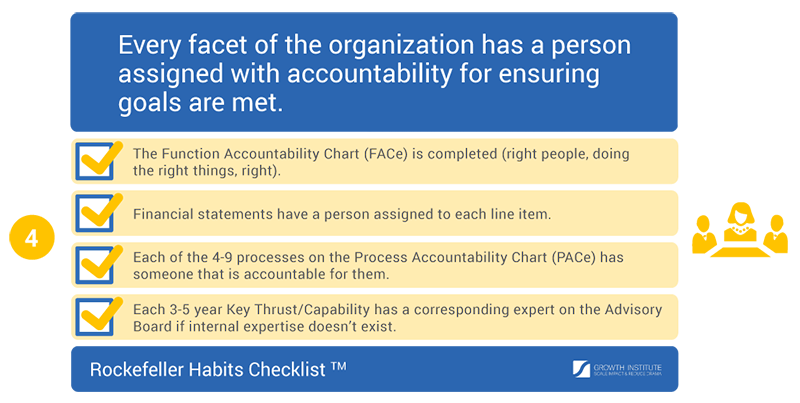
Rockefeller Habit #5
Ongoing Employee Input Is Collected To Identify Obstacles And Opportunities
-
All executives (and middle managers) have a Start/Stop/Keep conversation with at least one employee weekly.
-
The insights from employee conversations are shared at the weekly executive team meeting.
-
Employee input about obstacles and opportunities is being collected weekly.
-
A mid-management team is responsible for the process of closing the loop on all obstacles and opportunities.
Ah yes, data — both measurable and immeasurable data — will fuel clear decision-making. This is the first key component for qualitative data that you’ll need to guide the business. It is critical for senior leadership and middle managers to engage their employees in data collection from within the company. In other words, roll up your sleeves and prepare to take notes.
Here are some guidelines we recommend:
-
Collect data from your employees, especially your sales channels and those on the frontline as they are closest to the action.
-
Senior leaders should talk to one employee a week. Here is the question they should ask: “What should the company Start/Stop/Keep doing?”
-
Pay attention to the “Stops” as this will give you an idea of the roadblocks your people are facing and what to eliminate.
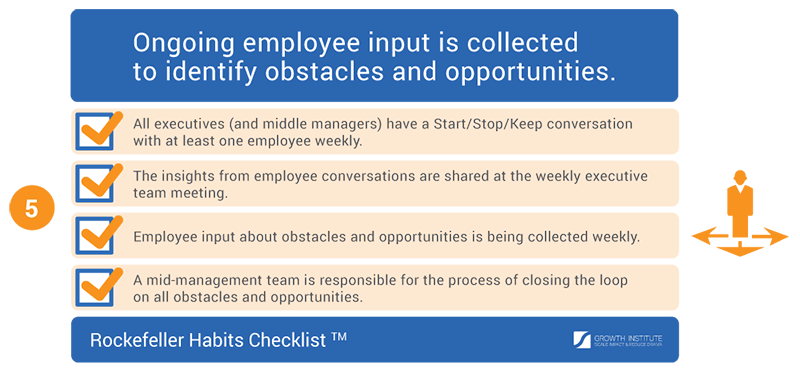
Rockefeller Habit #6
Reporting And Analysis Of Customer Feedback Data
Is As Frequent And Accurate As Financial Data
-
All executives (and middle managers) have a 4Q conversation with at least one end user weekly.
-
The insights from customer conversations are shared at the weekly executive team meeting.
-
All employees are involved in collecting customer data.
-
A mid-management team is responsible for the process of closing the loop on all customer feedback.
Next we will look at the data that will come from customers. With our method of execution, I advise all employees to talk to customers — as after employees, customers are the next biggest source of data that you can use to guide the growth of your organization.
In fact, I’d suggest senior leaders formally talk to one customer a week to gather data about the market and competitors.
Rockefeller Habit #7
Core Values And Purpose Are “Alive” In The Organization
-
Core Values are discovered, Purpose is articulated, and both are known by all employees.
-
All executives and middle managers refer back to the Core Values and Purpose when giving praise or reprimands.
-
HR processes and activities align with the Core Values and Purpose (hiring, orientation, appraisal, recognition, etc.).
-
Actions are identified and implemented each quarter to strengthen the Core Values and Purpose in the organization.
This habit will give you a baseline for current and future decisions, including when making a hire, sharing praise and when giving constructive criticism. I like to think of Core Values and Purpose as “alive’ in an organization.
Having a purpose (which to me, is a better way to say, “mission”), gives your company the critical “why” behind all that it does. Your purpose needs to be more than just making money.
Rockefeller Habit #8
Employees Can Articulate The Key Components
Of The Company’s Strategy Accurately
- Big Hairy Audacious Goal (BHAG) – Progress is tracked and visible.
- Core Customer(s) – Their profile in 25 words or less.
- 3 Brand Promises – And the corresponding Brand Promise KPIs reported on weekly.
- Elevator Pitch – A compelling response to the question “What does your company do?”
Does everyone in your organization know your brand strategy, including the three main brand promises? If everyone on your team can’t share your firm’s “elevator pitch” when asked, then you might need to work on your team’s alignment.
Rockefeller Habit #9
All Employees Can Answer Quantitatively Whether They Had A Good Day Or Week (Column 7 Of The One-Page-Strategic-Plan or OPSP)
-
1 or 2 Key Performance Indicators (KPIs) are reported on weekly for each role/person.
-
Each employee has 1 Critical Number that aligns with the company’s Critical Number for the quarter (clear line of sight).
-
Each individual/team has 3-5 Quarterly Priorities/Rocks that align with those of the company.
-
All executives and middle managers have a coach (or peer coach) holding them accountable to behavior changes.
Each member of your team (yourself included) should be able to answer the question,
“Did I have a great day or week?”
If they can’t, then it might mean that they are not clear on their priorities and their KPIs. In order to move forward together, everyone must be aligned. Think of your organization as if it were a machine. In order for the machine to work flawlessly, all parts must work well and work together.
Rockefeller Habit #10
The Company's Plans And Performance Are Visible To Everyone
-
A “situation room” is established for weekly meetings (physical or virtual).
-
Core Values, Purpose and Priorities are posted throughout the company.
-
Scoreboards are up everywhere displaying current progress on KPIs and Critical Numbers.
-
There is a system in place for tracking and managing the cascading Priorities and KPIs.
This habit basically boils down to having scoreboards everywhere! We encourage you to have your goals, metrics, and plans up around the company for everyone to see, keep track of and remain engaged with. Similarly make sure your core values and purpose are also posted throughout your firm so everyone has access to it.
Case Study - Gung Ho! Pizza
 At Gung Ho! Pizza co-founders Jade Gray and John O’Loghlen realized that since their stores are located in numerous locations, not all employees will make it to the headquarters to see the same information (company core values, priorities, purpose, etc.) that employees at the head office are privy to.
At Gung Ho! Pizza co-founders Jade Gray and John O’Loghlen realized that since their stores are located in numerous locations, not all employees will make it to the headquarters to see the same information (company core values, priorities, purpose, etc.) that employees at the head office are privy to.
Now, each of their locations also have the same information that is available in the head office, on a wall in their store, making it easy for everyone, from the cleaner to the store manager, to remain engaged with what’s happening in the company.
“Everyone from our cleaner to our store manager can look at the wall at the start of each daily meeting. This ensures we are aligned. I can walk into a store and speak with a cleaner and nine times out of 10, he or she can tell me what the Purpose of the company is and give me the meaning behind it and why we’re in business. How to align the entire team is the biggest thing this methodology has taught me,” says Gray.
How To Implement The Rockefeller Habits?
While the habits are listed in no particular order and you can start with whichever you want, we give our clients one rule —they must start with Rockefeller Habit #1: The executive team is healthy and aligned.
It is near impossible to implement any of the other habits without checking off Habit #1 first. Once that is realized and your team is ready to go (i.e. they can fight without killing each other), pick one or two habits each quarter and work on those.
Start with the habits that will have the most immediate benefits and over the next 24 to 36 months, you will have been able to get through all 10 habits. Outside of Rockefeller Habit #1, the order is up to you.
This isn’t a one-time thing but a process that will make your journey easier. As the company scales up, you can continue to refresh the habits.
Who Should Use These Habits?
By all means, these habits aren’t the only way to build a long-lasting organization. However, if your business:
-
Has been wasting massive amounts of money and time;
-
Has a great strategy but your team must work 18-hour days to make up for sloppy execution and lack of discipline;
...then this execution list is for your organization. Follow the implementation guidelines above and see the difference that it will make. Let me know when it starts working 😉
Where Does Your Company Stand?
As you can see, the formula is actually simple.
- Make sure everyone feels safe and free to participate
- Get your priorities straight
- Gather data
- And make sure everyone and everything works like a well-oiled machine.
Knowing the formula is the easy part, successfully implementing the formula is where things get tricky. Throw in a large organization with many different people and parts and things can get out of hand. That’s where these habits come in. It is the rudder that will help you steer the company’s ship to scaling up.
For a practical way to learn how to apply these habits into your current business while getting mentorship, peer-to-peer feedback, and customized support as you implement, check out my Scaling Up Master Business Course here.
Already implementing one or all of the 10 Rockefeller Habits in your business?
Leave a comment and let us know how it’s helped you scale up.
Recommended Books:
- Great by Choice: Uncertainty, Chaos, and Luck — Why Some Thrive Despite Them All by Jim Collins and Morten T. Hansen. by Patrick M. Lencioni.
- The Great Game of Business: The Only Sensible Way to Run a Company by Jack Stack.
- Competing on Internet Time: Lessons From Netscape and Its Battle With Microsoft by Michael A. Cusumano and David B. Yoffie.


.png?width=800&name=GI_Execution_Rockefeller-Habits-ChecklistTM_Infographics_CUT-1%20(1).png)
